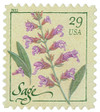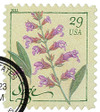
2011 29c Herbs: Sage
# 4509 - 2011 29c Herbs: Sage
$0.75 - $4.25
U.S. #4509
2011 29¢ Sage
Herbs
Issue Date: April 7, 2011
City: New York, NY
Printed By: Avery Dennison
Printing Method: Photogravure
Color: Multicolored
Since ancient times, the herb sage was revered as a key to immortality. Sage, whose Latin root word salvia means “to heal,” was prized for its medicinal purposes. Cultures from Europe to the Arab world believed that consuming sage could grant eternal life, or at least help a person live a great many years. “Why should a man die, when he can go to his garden for sage?” was a saying from the 10th-century medical school in Salerno, Italy.
Sage was of such importance that Charlemagne, the first Holy Roman Emperor, ordered it grown in the imperial gardens in Germany. The herb was widely used for medicine. It was believe to improve memory, relieve sore throats, aid digestion, and treat snake bites.
While revered as a “cure-all,” sage steadily gained popularity in food and drinks. As a tea, it was so treasured by the Chinese that 17th-century Dutch traders were able to get three or four times the weight of green tea in return.
Sage was originally used as a meat preservative, but cooks have learned it is a perfect complement to fatty meats like pork and duck. With a slightly bitter and pungent taste, sage is best used lightly, as a little goes a long way. And while its flavor may not make one immortal, it can add to culinary pleasure.
U.S. #4509
2011 29¢ Sage
Herbs
Issue Date: April 7, 2011
City: New York, NY
Printed By: Avery Dennison
Printing Method: Photogravure
Color: Multicolored
Since ancient times, the herb sage was revered as a key to immortality. Sage, whose Latin root word salvia means “to heal,” was prized for its medicinal purposes. Cultures from Europe to the Arab world believed that consuming sage could grant eternal life, or at least help a person live a great many years. “Why should a man die, when he can go to his garden for sage?” was a saying from the 10th-century medical school in Salerno, Italy.
Sage was of such importance that Charlemagne, the first Holy Roman Emperor, ordered it grown in the imperial gardens in Germany. The herb was widely used for medicine. It was believe to improve memory, relieve sore throats, aid digestion, and treat snake bites.
While revered as a “cure-all,” sage steadily gained popularity in food and drinks. As a tea, it was so treasured by the Chinese that 17th-century Dutch traders were able to get three or four times the weight of green tea in return.
Sage was originally used as a meat preservative, but cooks have learned it is a perfect complement to fatty meats like pork and duck. With a slightly bitter and pungent taste, sage is best used lightly, as a little goes a long way. And while its flavor may not make one immortal, it can add to culinary pleasure.










